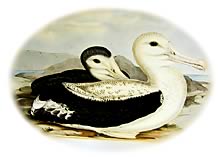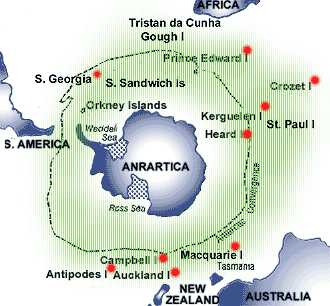
Albatross
(Derived from the Arabic word al-cādous(meaning pelican)or the Portuguese word... alcatraz!)
The Albatross

Albatross
(Derived from the Arabic word al-cādous(meaning pelican)or the Portuguese word... alcatraz!)
Probably one of the most mythical birds to fly the planet's skies the Albatross has been the source of tales and superstitions since the time of the ancient civilizations. Supposed harbinger of back luck the Albatross is none the less my favourite bird. It symbolizes both independence and fidelity and although it is seen as a solitary observer riding the winds of life with apparent aloofness it is in fact just another case of Darwin's natural selection at work, at least it would be without man's interference (see survival status below).
Description
The Wandering Albatross is the largest of the albatrosses and is the living bird with the greatest wingspan, measuring almost 3.5 m. The body length is up to 1.35 m, with females slightly smaller than males. The adult Wandering Albatross appears entirely white from a distance. Close up, the fine black wavy lines on the breast, neck and upper back become visible. The bill can vary in colour but is normally yellowish-pink. The white tail is occasionally tipped with black and the back of the wing changes from black to white with age. A series of plumage phases are passed through as young birds reach full adult plumage, which can take up to nine years. During these changes, identification can be difficult, and birds may be confused with other large albatrosses with similar colourings
Facts
Food and Feeding
Birds are often seen scavenging scraps from fishing boats, but squid and fish are the preferred food. Galley refuse and floating waste also form part of the diet. Feeding is one of the few times that birds land, and this is mostly undertaken at night.
They feed on squid. They are particularly vulnerable to being caught on longlines because they view anything on or near the surface as a potential food item and are liable to seize baits (and the hooks therein) as fishing vessels set their lines. Longlining is probably the biggest single killer of Wandering Albatross each year.
Breeding
Pairs mate for life and breed every two years. Breeding takes place on subantarctic islands and commences in early November. The nest is a mound of mud and vegetation and is placed on an exposed ridge near the sea. The single egg hatches after two months and the chick remains in the nest for approximately nine months. During the early stages of the chick's development, the parents take turns to sit on the nest while the other searches for food. Later, both adults hunt for food and visit the chick at irregular intervals.
NB - because it takes a year to complete the breeding cycle. The couple incubates their single egg for 11 weeks and the take a further 40 weeks to fledge their chick, which is dependent upon the parents for food over this entire period. The chick perishes if either parent is lost at sea to longlines because a single parent cannot collect enough food.
Breeding Season: Egg laying - December to February; Hatching - March to April; Fledging - November to February.
Population*: The total number of individual Albatross is around 134,500. Each year around 20,682 pairs attempt to breed.

* Populations
Albatrosses are of different populations but have similar biology. Difficult to tell apart at sea they are generally treated as one group, the "Wandering Albatross". While most sources consulted are in agreement that the majority of the world's albatrosses nest in sub-antarctic waters in the southern hemisphere, with the exception of one that nests on or near the equator (see source #3 below) there appear to be divergences in the way Albatrosses are subdivided:
Source #1 - One source has subdivided the Albatross into the following 4 regional species:
Source #2 - divides the Albatrosses into another four groups:
Source #3 - mentions that three species of Albatross breed in the north Pacific, and one, the Waved Albatross of the Galapagos actually breeds on the equator. It, too, is quite a rare species, nesting only on the Española Island.
Dynamic Soaring
Albatrosses are able to fly for hours, and maybe even days. To cover such large distances Albatrosses not only use an incomparable muscle power but they also use a technique called "Dynamic Soaring". This technique consists of determining the winds direction then flying downwind so that the wind is actually pushing the bird, thus enabling the bird to cover enough distance with relatively little actual physical effort and to change direction the Albatross has only to lift its wing enabling it to glide across wind (See the animation below).

Survival Status
The Albatross is considered "Vulnerable" and "Endangered" on the "IUCN* Red List Of Threatened Species". Numerous cases of Albatrosses being caught in fishing lines (Longlines) and other fishing paraphernalia, deliberate acts of malevolence coupled with the fact that Albatrosses only give birth to a single egg during a given breeding season, mean that the world's Albatross population is endangered.
(* The International Union for Conservation of Nature and Natural Resources)
NB. Antipodean, Gibson's and Wandering albatrosses are classed as "Vulnerable"; the small population of Tristan albatross are classified "Endangered". Of the eight population study sites where reliable data is available, four are declining, one very small population is now stable after a period of decline, and three are increasing.

Note to map: Wandering albatross are circumpolar between around 40 and 60 degrees south latitude, although at times they will penetrate further south into the pack ice - in the Ross Sea, as far as 70 degrees south.
Albatrosses in Literature
Extract from Part I "The Rime of the ancient Mariner" by Samuel Taylor Coleridge - possibly the best-known reference to the Albatross in literature:
"At length did cross an Albatross:
Thorough the fog it came;
As if it had been a Christian soul,
We hailed it in God's name."
Dylan Thomas: Quite Early One Morning:
"...I would have told him: 'Arise old counter of the heartbeats of albatrosses, and wake the cavernous sleepers of the town to a dazzling new morning.' I would have told him..."
Albatrosses: Superstitions, Omens and Interpretations:
Acknowledgments:
Thanks to "Australian Museum" for certain facts and the "Greenpeace" Southern Atlantic Pirate Fishing program for other data.
© 2015 Nick Richards.